For #ThrowbackThursday, we revisit the most popular project story on Geosynthetica from 2018. The story was originally published 29 January 2018, which gave Oriokot’s article on the use of dewatering bags for desludging applications a good jump on its project story competition in that year; but, it needs to be pointed out that its first month of readership interest also outperformed other 2018 stories across a similar 4-week first-run sample.
By Johnny Oriokot, Donovan Bate, and Gerard Dirks – When wastewater treatment ponds reach their capacity, the options available are either to build new or empty existing facilities. These ponds must be desludged to make available additional space for waste. Strict environmental regulations in wastewater treatment, though necessary, can complicate carrying out functional upgrades to a facility.
Here, geotextile dewatering bags provide an efficient, cost-effective method for desludging works. They can work within a limited footprint and effectively contain the material that needs to be removed and disposed of with minimal environmental impact.
GEOTEXTILE DEWATERING BAGS IN SOUTH AFRICAN WASTEWATER
The ultimate goal of wastewater treatment is, of course, to convert unsuitable fluid into an effluent that is safe to be returned to the environment. Solid particles (sludge) are separated from the wastewater and transported to safe disposal sites or contained in a tailings storage facility.
Cost-effective and efficient solids separation remains a challenge to wastewater tailings facilities around the world.
South Africa serves as a strong example for tackling common wastewater treatment issues with the utilization of geotextile dewatering bags. Here, multiple wastewater treatment sites were identified as having reached their maximum storage capacity. Excess sludge accumulation was a major factor.
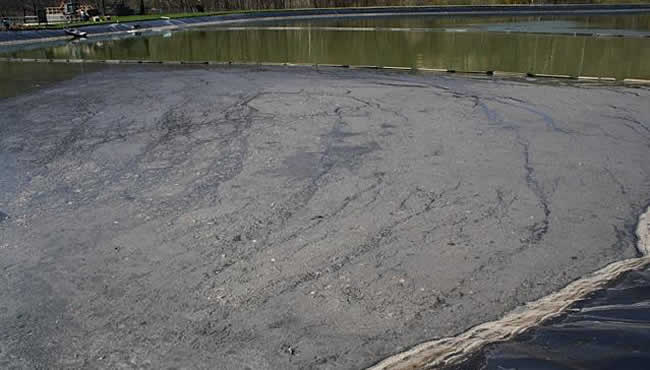
For all of the facilities cited in Figure 1, the option of building a new tailings dam was cost-prohibitive. (This is the case nearly all wastewater treatment plants find themselves in when reaching capacity.) Furthermore, the tailings storage facilities in place at these sites, like so many others, were older and had not been constructed with an adequate lining system. Thus, the sites presented an environmental concern over potential effluent leakage.
MORE GEO: Dewatering Tubes Solve Stormwater Blockage in Brisbane River
To remedy the situation and relieve these facilities of the concern over the old tailings storage cells, a project was initiated to remove sludge from each facility, rehabilitate the storage cells, and install modern lining systems. The work was conducted not only to achieve better environmental and efficiency performance but to bring the facilities quickly up to the standards set by new regulations enacted by the Department of Water Affairs.
SLUDGE REMOVAL AND DEWATERING OPTIONS
Dredging is by far the most common form of sludge removal followed by other methods that involve mechanical removal from a tailings dam. The sludge is removed, dried, and transported to a landfill or a land-application facility. Dredging, however, can be an extremely difficult, time-consuming, and costly process. Dredging can also damage a lining system, which can compromise the structural integrity of the sludge pond and lead to seepage.
For the South African projects described here, limited budget and time-sensitive operational upgrade windows for desludging the wastewater ponds pressured the project teams to find alternative methods. On-site geotextile dewatering bags were found to be a more economical and smaller footprint solution.
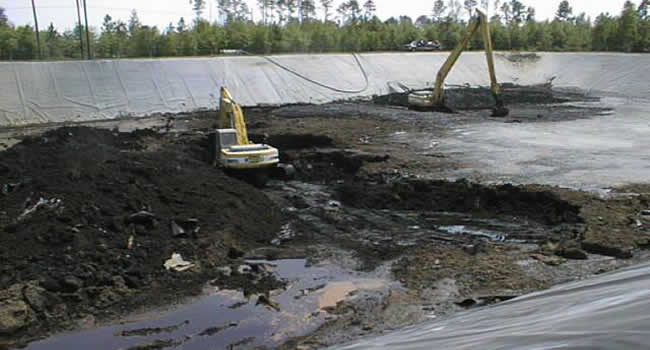
DESIGNING WITH DEWATERING BAGS
For the projects here, a dewatering area was lined with a 1-mm-thick geomembrane to prevent local erosion and to collect all the effluent that would be released from the geobags during the dewatering process. The effluent would then be channeled back into the dam or taken for further treatment.
The geotextile dewatering bags made out of UV-stabilized woven polypropylene (PP) geotextile material with high-strength seams were used to capture the dredged sludge whilst minimizing water loss. The seam strength of a geotextile dewatering bag is essential for durability in service and to withstand the stresses associated with pumping the material at high pressures. The thread used to stitch the bags in this project series offered a higher breaking strength than the geotextile itself, thus providing sufficient tensile strength to the geobags.
One of the primary sources of efficiency in the use of geotextile dewatering bags rests in how they allow water to flow through the geotextile pores while filtering out the solids, which are contained inside the bag. Even solids smaller than the aperture openings in the fabric are contained, as a filter cake builds up during the dewatering process but does not entirely block water flow. This creates an equivalent two-stage filter with filtration efficiencies above 98% for fine-grained material filtered through woven, high-strength geotextile dewatering bags (Bindra 2002).
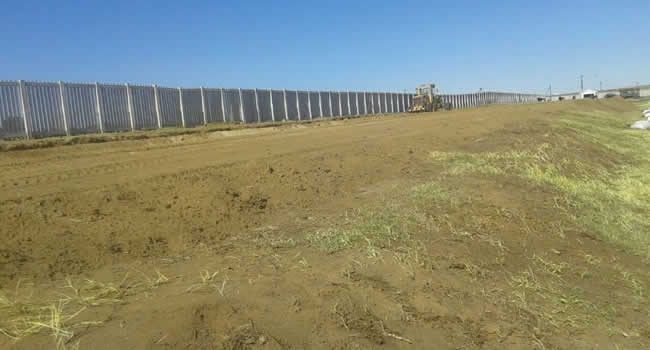
In order to accommodate the pipe connections, two inlets per bag of standard size 200 mm were allowed for. These inlets accommodated pipe sizes up to 200 mm diameter. When filling processes were completed, the pipes were removed and the inlets were tied off.
The pumping rate was kept below 40 m³/h. A manifold was present to split the flow and reduce the inlet speed in the event a pump exceeded the designed rate. The pumping rate did not affect the flow-through rate of the geotextile dewatering bags, because the aperture size of the geotextile controls the outflow.
MORE GEO: Sludge Lagoon Remediation with Geosynthetics
When it comes to disposal, the final disposal site for the dewatering geotextile bags should be as close to the generation area as possible in order to minimize transportation costs. The retained solids can be safely disposed of or perhaps reused beneficially, such as in fertilizer. The geobags themselves must by disposed of responsibly, as they are not reusable.
In selection of a disposal site, one must:
- Ensure that the disposal site is not located in a sensitive area where disposal is not permissible
- Ensure that the sludge disposal site is located as far as possible from the area where the final effluent is discharged to limit possible contamination of the final effluent, as well as to limit possible contribution of contaminants to the water resource
- Allow for the maximum buffer zones, greater than 400 m from surface water
- Consider the slope of the disposal site to minimize run-off, erosion, and ponding.
- Ensure the disposal site is not within the 1:100 year flood line.
No flocculants were necessary, as the use of geobags enabled the material to dewater quick enough by gravity only, further reducing project cost.
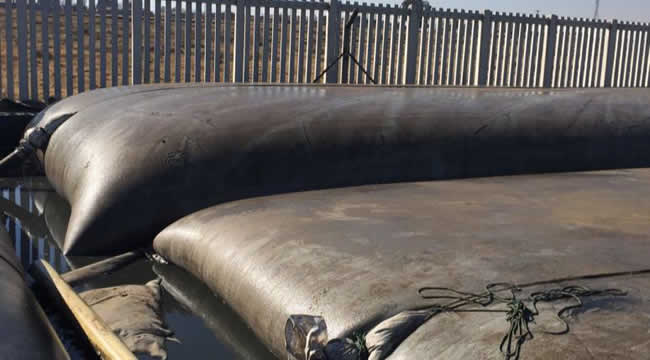
While the duration dewatering and consolidation by this method varies depending on the type of geotextile, bag size, fill material, and site conditions, in the authors’ experience it takes on average a week for these types of bags to drain.
TAKEAWAYS FOR WASTEWATER ENGINEERING
Geotextile dewatering bags are capable of competing economically with other dewatering techniques used at wastewater treatment plants. The use of a geobag technique is passive. It does not require extensive or constant monitoring and maintenance of equipment. As such geotextile dewatering bags are, in general, 50 – 70% cheaper than other sludge removal methods, when considering all factors (e.g., construction and dewatering time, labor, machinery costs). The simplicity in their use for separating solids and how simple it is to contain the effluent that is dewatered also makes geobags an environmentally friendly engineering solution. Aquaculture, industrial processing, and sedimentation ponds are some other applications that benefit from the utilization of geotextile dewatering bags.
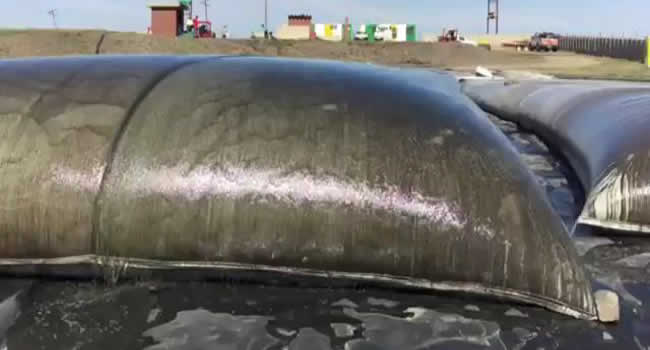
Geobag size selection is dependent on the volume that needs to be removed from a tailings facility and the space available on site where the dewatering bags will be placed. The largest geobag in the project noted here had a 15m circumference and was 60m long. This provided approximately 720 m3 of volume.
The cost of geotextile dewatering bags is determined by the woven geotextile material, the thread strength, and the stitching process.
One can also find advantages in measuring the volume of waste that can be extracted from a tailings dam per month per bag, though this analysis has not yet been conducted for the sites noted here in South Africa.
At the time the article was published, the authors worked for or partnered with Fibertex South Africa on the project. Visit Fibertex’s geosynthetics page for more information about the materials and dewatering strategies referred to in the story.
Today, Johnny Oriokot is with PSM Technologies | Presto Geosystems. Donovan Bate works for TeMa. Gerard Dirks work for HUESKER.
RECOMMENDED READING
Bindra, M. W. (2002). Dewatering of Dredged Material Using Geotextile Tubes. In Proceedings of these 2004 International Erosion Control Conference, Philadelphia, PA (pp. 203-212).
Gaffney, D. A., S. M. Martin, M H. Mahir, and T. A. Bennert. (1999). “Dewatering Contaminated, Fine Grained material Using Geotextiles.” Geosynthetics ‘97 Conference Proceedings, Boston, USA. Vol. 2. pp 1017–1032.
GRI-GT8. (2014). Fine Fraction Filtration Using Geotextile Filters. Geosynthetic Research Institute.
GRI-GT10. (2012) Test Methods, Properties and Frequencies for High Strength Geotextile Tubes used as Coastal and Riverine Erosion Control Structures. Geosynthetic Research Institute.
GRI-GT11. (2012). Installation of Geotextile Tubes used for Coastal and Riverine Structures. Geosynthetic Research Institute.
GRI-GT14. (2014). The Hanging Bag Test for Field Assessment of Fabrics Used for Geotextile Bags. Geosynthetic Research Institute.
Guidelines for the Utilization and Disposal of Wastewater Sludge – Volume 3. (2007). Requirements for the on-site and off-site disposal of sludge of wastewater sludge. WRC Report No. TT 349/08. 2007.
Mastin, B. J., Lebster, G. E., & Salley, J. R. (2008). Use of Geotube® dewatering containers in environmental dredging. Proceedings of GeoAmericas, 390-399.











